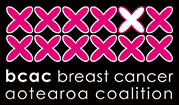The Breast Cancer Aotearoa Coalition (BCAC) welcomes new funding for the Government’s drug-buying agency, PHARMAC, but warns that it is not enough to make a real difference.
The Government has announced a $60 million increase in funding for PHARMAC over the next four years as part of Vote Health in Budget 2017.
BCAC chairperson, Libby Burgess, says that even with the $60 million increase, New Zealand’s funding for new medicines remains low.
“This increase amounts to $4 per person per year for medicines – less than the cost of a cup of coffee! Yet $40 per person per year would pay for medicines currently on the Medicines Waiting List that PHARMAC’s technical experts have recommended, but which have not been funded by PHARMAC’s board,” Ms Burgess says.
She says a recent Medicines Australia report found that only 13 per cent of new medicines were funded in New Zealand, compared to around 80 per cent in the UK and 40 percent in Australia.
“Our lack of funding for new and innovative medicines is robbing New Zealanders with serious illnesses of the opportunity to live full and long lives. We need a significant funding boost for medicines in this country to ensure we can offer first-world healthcare,” Ms Burgess says.
At the moment, Kiwis with breast cancer are missing out on at least four new medicines that have been shown to save and improve the lives of women with the disease and are available to women in Australia.
BCAC launched a campaign last year calling for a dramatic increase in funding for new medicines and Ms Burgess says the charity will continue to push for New Zealanders to have better access to innovative medicines that could potentially save lives.
ENDS
25 May 2017
About medicines’ funding in New Zealand:
- New Zealanders with breast cancer are 40% more likely to die than Australians.[1]
- Australia spends $435 per person on medicines, but in New Zealand we will spend a mere $184 per person in 2017/18[2]
- In the UK, 80% of approved new medicines are publicly funded, in Australia 39%, but in New Zealand it’s only 13%.[3]
- Between 2009 and 2014, New Zealand ranked last out of 20 OECD countries in access to new medicines.[4]
- Breast cancer drugs including Kadcyla, Abraxane, Afinitor and Halaven are publicly-funded in Australia but not in New Zealand.[5]
[1] Campbell I.D., Scott N., Seneviratne S., Kollias, J., Walters D, Taylor, C, Webster F, Zorbas H and Roder DM 2014. Breast cancer survival in New Zealand women. ANZ J Surg. 2015 Jul;85 (7-8):546-52. doi: 10.1111/ans.12851.
[2] PHARMAC NZ; Pharmaceutical Benefits Scheme, Australia; Statistics NZ; Australian Bureau of Statistics.
[3] Access to New Medicines: Comparison Across OECD Countries. IMS Consulting Group, Report for Medicines Australia, 2015; Comparison of Access and Reimbursement Environments: A report benchmarking Australia’s access to new medicines. Medicines Australia (2015).
[4] Access to New Medicines: Comparison Across OECD Countries. IMS Consulting Group, Report for Medicines Australia, 2015; Comparison of Access and Reimbursement Environments: A report benchmarking Australia’s access to new medicines. Medicines Australia (2015).
[5] Schedule of Pharmaceutical Benefits: Effective 1 September 2016. PBS, Department of Health, Australian Government. www.pbs.gov.au
New Zealand Pharmaceutical Schedule: effective 1st October 2016. Pharmaceutical Management Agency (PHARMAC).



